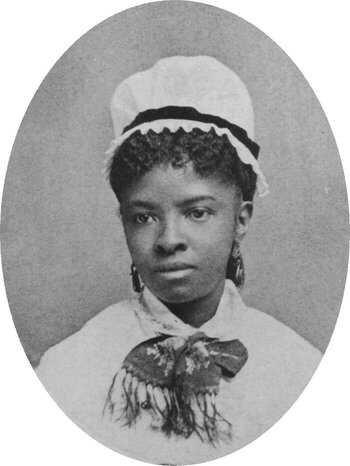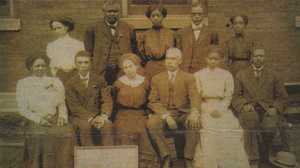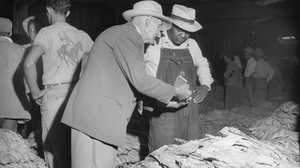African American Medical Pioneers
From the Collection: The African American ExperienceVivien Thomas followed in the footsteps of other African Americans who made advances in medicine and helped to improve people's lives.
Explore the profiles of six pioneers who held themselves to a standard of excellence, although the odds were stacked against them.

Mary Eliza Mahoney (1845 - 1926)
Mary Eliza Mahoney was the first black professional nurse in America, and an active organizer among African American nurses. She was born in Boston, on May 7, 1845, the oldest of three children. At the age of 18, she decided to pursue a career in nursing, working at the progressive New England Hospital for Women and Children. In 1878, at age 33, she was accepted in that hospital's nursing school, the first professional nursing program in the country. Of the 42 students who started that year, Mahoney was one of just four who graduated the next year. The training required 12 months in the hospital's medical, surgical, and maternity wards, lectures and instruction by doctors on the ward, as well as four months of work as a private-duty nurse.
After graduation, Mahoney registered for work as a private-duty nurse. Families that employed Mahoney praised her calm and quiet efficiency. Her professionalism helped raise the status of all nurses. At a time when nurses were often assigned domestic chores as well as nursing duties, she refused to take her meals with household staff. As he reputation spread, Mahoney received requests from patients as far away as New Jersey, Washington, D.C., and North Carolina.
Mahoney was one of the first black members of the organization that later became the American Nurses Association (A.N.A.). When that later organization proved slow to admit black nurses, Mahoney strongly supported the establishment of the National Association of Colored Graduate Nurses (N.A.C.G.N.), and delivered the welcome address at that organization's first annual convention, in 1909. In that speech, Mahoney recognized the inequalities in nursing education and called for a demonstration at the New England Hospital to have more African American students admitted. The conference members responded by electing her to be association chaplain and giving her a lifetime membership.
For over a decade after that, Mahoney helped recruit nurses to joint the organization. In 1911 she took the helm at the Howard Orphan Asylum in New York, and served there for over a year.
Mahoney was deeply concerned with women's equality and a strong supporter of the movement to gain women the right to vote. When that movement succeeded with the passage of the Nineteenth Amendment in 1920, she was among the first women in Boston to register to vote — at the age of 76.
Mahoney contracted breast cancer in 1923 and died in 1926. Her grave in Everett, Massachusetts, is the site of national pilgrimages. In 1936, the N.A.C.G.N. established an award in her honor (later continued by the A.N.A.) to raise the status of black nurses. She was inducted into the A.N.A.'s Hall of Fame in 1976.
The effort for equality that Mahoney launched continued. From about 2,400 in 1910, the number of African American women in nursing had more than doubled by 1930, four years after Mahoney's death.
Charles Drew (1904-1950)
Charles Richard Drew was a physician, researcher, and surgeon who revolutionized our understanding of blood plasma. During World War II alone, his work allowed blood storage for transfusions that saved many thousands of lives. Drew was born the eldest of five children on June 3, 1904, in Washington, D.C. His father was a carpet installer and his mother was a schoolteacher. Drew, an excellent student and athlete, graduated from Washington's Dunbar High School in 1972. After graduating from Amherst College in 1926, he applied to medical school but, like Vivien Thomas, could not afford the tuition. He taught science at a black college in Baltimore for several years and saved his earnings. In 1929, he started medical school at McGill University in Canada.
Drew's research on blood transfusions followed the discovery that human blood could be categorized into four main types (A, B, AB, O). Drew received his medical degree and Master of Surgery degree at McGill, and completed his residency at Montreal General Hospital. He returned to Washington, D.C. to help care for his family after his father died, and he began teaching at Howard University's medical school. In 1938, he accepted a fellowship to continue his blood research at Columbia University. There, Drew developed a method for processing and storing blood plasma that allowed it to be dehydrated, shipped great distances, and then reconstituted just before transfusions. This was a great breakthrough. Before then, unprocessed blood was very perishable and would become unusable after about a week.
Early in World War II, Drew received an urgent cable from his former professor, Dr. John Beattie, then in Britain. The cable asked Drew to send 5,000 ampules of dried plasma to Britain for wartime transfusions. "Work immediately and follow this by equal quantity in three to four weeks," the cable said. It was a shocking request: there was not that much plasma in the whole world. But Drew took the challenge. By September 1940, he led the "Blood for Britain" project as Nazi Germany's air assault on Britain reached its height.
When "Blood for Britain" succeeded, Drew became director for the blood bank of the American Red Cross. He organized the largest blood drive ever, involving 100,000 donors, for the U.S. Army, and Navy. Drew was infuriated when the military ordered the Red Cross to label the blood with each donor's race and to refuse African American donors. Despite his protests that the policy was unscientific and insulting, the government continued to segregate blood banks. He resigned.
Drew resumed teaching at Howard and became chief surgeon at Freedmen's Hospital. In 1943, he became the first black surgeon to be an examiner for the American Board of Surgery. He inspired his students and received many awards and honorary degrees. Later, he was elected to the International College of Surgeons, and traveled through post-war Europe to assess hospitals as and advisor to the U.S. Surgeon General. He died in a car accident in March 1950, while driving to a medical meeting at the Tuskegee Institute.
Drew left a legacy of life-saving techniques and teaching. Many of his students also went on to become nationally prominent physicians.
Daniel Hale Williams (1856-1931)
The son of a barber, Daniel Hale Williams founded the first black-owned hospital in America, and performed the world's first successful heart surgery, in 1893. Williams was born in 1858 in Hollidaysburg, Pennsylvania, the fifth of seven children. After his father died, his mother, Sara Price Williams, moved the family several times. Young Daniel started as a shoemaker, but quickly knew he wanted more education. He completed secondary school in Wisconsin. At age 20, Williams became an apprentice to a former surgeon general for Wisconsin. Williams studied medicine at Chicago Medical College.
After his internship, he went into private practice in an integrated neighborhood on Chicago's south side. He soon began teaching anatomy at Chicago Medical College and served as surgeon to the City Railway Company. In 1889, the governor of Illinois appointed him to the state's board of health.
Determined that Chicago should have a hospital where both black and white doctors could study and where black nurses could receive training, Williams rallied for a hospital open to all races. After months of hard work, he opened Provident Hospital and Training School for Nurses on May 4, 1891, the country's first interracial hospital and nursing school.
One hot summer night in 1893, a young Chicagoan named James Cornish was stabbed in the chest and rushed to Provident. When Cornish started to go into shock, Williams suspected a deeper wound near the heart. He asked six doctors (four white, two black) to observe while he operated. In a cramped operating room with crude anesthesia, Williams inspected the wound between two ribs, exposing the breastbone. He cut the rib cartilage and created a small trapdoor to the heart.
Underneath, he found a damaged left internal mammary artery and sutured it. Then, inspecting the pericardium (the sac around the heart) he saw that the knife had left a gash near the right coronary artery. With the heart beating and transfusion impossible, Williams rinsed the wound with salt solution, held the edges of the palpitating wound with forceps, and sewed them together. Just 51 days after his apparently lethal wound, James Cornish walked out of the hospital. He lived for over 20 years after the surgery. The landmark operation was hailed in the press.
In 1894, Dr. Williams became chief surgeon of Freedmen's Hospital in Washington, D.C., the most prestigious medical post available to African Americans then. There, he made improvements that reduced the hospital's mortality rate. In 1895, he helped to organize the National Medical Association for black professionals, who were barred from the American Medical Association. Williams returned to Chicago, and continued as a surgeon. In 1913, he became the first African American to be inducted into the American College of Surgeons.
As a sign of the esteem of the black medical community, until this day, a "code blue" at the Howard University Hospital emergency room is called a "Dr. Dan." In words that could later be said of Vivien Thomas, a colleague wrote, "His greatest pride was that directly or indirectly, he had a hand in the making of most of the outstanding Negro surgeons of the current generation."
Dr. Williams died in 1931. The Daniel Hale Williams Medical Reading Club in Washington, D.C., commemorates his achievements.
James McCune Smith (1813 - 1865)
James McCune Smith was the first African American to earn a medical degree and practice medicine in the United States. He was also the first to own and operate a pharmacy, in New York City. Smith was born on April 18, 1813 in New York City to parents who were former slaves. New York's Emancipation Act freed his father and his mother worked her way out of bondage. Smith began his education at the African Free School in New York City, but soon found he could go no further in U.S. education due to racial discrimination.
So Smith crossed the Atlantic and studied instead at the University of Glasgow, in Scotland, where racial prejudice was less oppressive. There, he received a bachelor's degree in 1835, a master's degree in 1836, and his medical degree in 1837.
When he returned to the United States, Smith received a hero's welcome from New York's black community. He told the gathering, "I have striven to obtain education, at every sacrifice and every hazard, and to apply such education to the good of our common country." Soon after that, he gave a speech at the annual meeting of the American Anti-Slavery Society, where he described abolitionist activities in Europe.
He began a medical practice in New York and opened a pharmacy on West Broadway. It is said to be the first African American owned and operated pharmacy in the United States.
Dr. Smith practiced medicine for 25 years, primarily at the Free Negro Orphan Asylum. He frequently gave speeches against slavery, and wrote essays for antislavery publications, including the Emancipator and the Liberator. Smith used science and his knowledge of medicine to refute false claims of slavery advocates. In one essay, he marshaled statistics against a minister's claim that slaves in the South were more content than free blacks in the North. In another, he applied his medical knowledge to counter assertions about black health and insanity.
Smith wrote an introduction for frederick douglas' second autobiographical volume, My Bondage and My Freedom. There, he wrote that Douglass' life story "shows that the worst of our institutions, in its worst aspect, cannot keep down energy, truthfulness, and earnest struggle for the right."
In 1863, Smith was appointed professor of anthropology at Wilberforce University, in Ohio. He died two years later in New York, survived by his wife and five children.
Rebecca Lee Crumpler (1833-?)
Rebecca Crumpler devoted her life to improving health in the black community through research and clinical work. After a full career of helping patients, she published a book designed to help a broader audience of women and children.
Crumpler was born in 1833 and raised by an aunt in Pennsylvania. That aunt, who attended to the health needs of the people near her, was her niece's first inspiration. In the 1850s, Crumpler worked as a nurse in Massachusetts, where her dedication gained her notice from her supervisors. With their recommendations, she entered the New England Female Medical College in Boston (which later merged with Boston University's medical school). On graduation day in 1864, Crumpler received a Doctress of Medicine degree.
Dr. Crumpler started a practice as a general practitioner serving many Boston families. When the Civil War ended the following year, she understood the urgent need for medical care among newly freed slaves in the South, and relocated her medical practice to Richmond, Virginia. There her reputation for excellent care and hard work spread quickly. She worked in Richmond's black community for many years before returning to Boston with her husband, Dr. Arthur Crumpler.
Back in Boston, Crumpler established a practice at 67 Joy Street dedicated to serving women and children, especially through nutrition and preventative medicine. At that time she also began reviewing her journals and research. Hoping to educate the public about health, she wrote a book about her experience. In 1883 a Boston publisher, Cushman, Keating & Company, published her two-volume work, A Book of Medical Discourses. It offered women a reference on how to provide medical care for themselves and their children.
Dr. Crumpler inspired many as a model for breaking barriers, and for dedicating oneself to improving the lives of others.
William Augustus Hinton (1883 - 1959)
William Augustus Hinton was born on December 15, 1883 in Chicago. His parents, Augustus Hinton and Maria Clark, were both enslaved. Hinton grew up in Kansas. After high school, he studied at the University of Kansas, finishing the premedical program in just two years instead of the usual three. Hinton continued undergraduate studies at Harvard, receiving a bachelor's degree there in 1905.
Hinton worked for a time in a law office, and then taught science at Waldo University in Tennessee before pursuing a career in medicine.
In 1909, Hinton was offered a scholarship reserved for African American students, but instead of accepting it, he chose to compete for a scholarship open to all students, the Wigglesworth scholarship. He won the scholarship two years in a row. Hinton finished the Harvard medical program in just three years instead of the usual four. He received his M.D. in 1912.
After graduating, Hinton began work at the Wassermann Laboratory at Harvard, and by 1915 he had become director of the lab. The lab was the official lab for the Massachusetts State Department of Public Health. In 1916, he also assumed the job of chief of the Boston Dispensary's laboratory department, where he created a program to train women as lab technicians. That helped to open the profession to women.
For most of his research career, he worked on laboratory tests designed to improve the diagnosis of sexually transmitted diseases. In 1927, he developed a test --later known as the Hinton test -- for diagnosing syphilis. It was easier, less expensive, and more accurate than previous methods, and was adopted as the standard procedure for diagnosing syphilis. Later, Hinton helped to develop another diagnostic test known as the Davies-Hinton test.
As a professor, Hinton taught preventative medicine and hygiene at Harvard from 1923, for 27 years. His book on syphilis, a serious public health threat, became widely acclaimed. Hinton noted the role of socioeconomics in health and called syphilis "a disease of the underprivileged."
Hinton also worked as a special consultant to the U.S. Public Health Service and taught at Tufts University and Simmons College. Despite losing a leg in a car accident in 1940, he continued to teach at Harvard until 1950, and kept working at the Wassermann laboratory until 1953. Like Vivien Thomas, he was an avid gardener and furniture craftsman. Hinton died in 1959 in Massachusetts at the age of 75.







